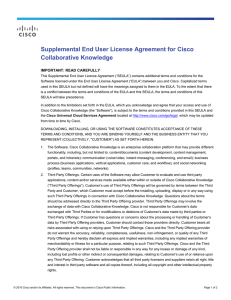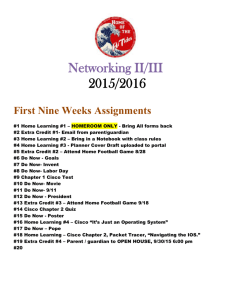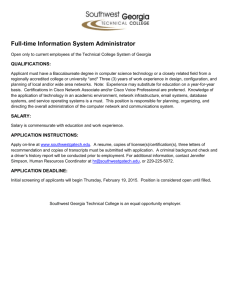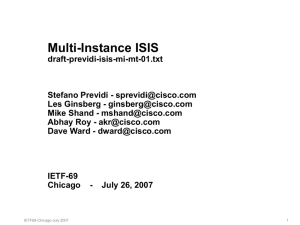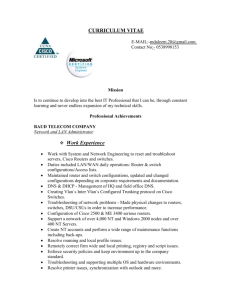Cisco Services are most attractive to customers when they are sold
advertisement
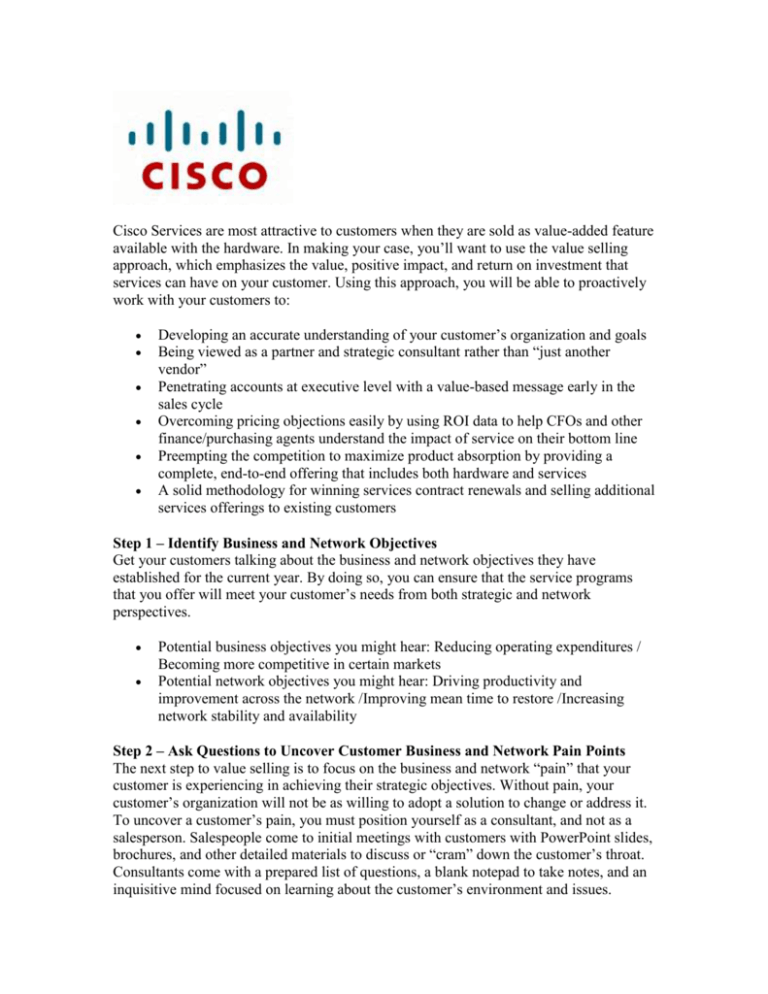
Cisco Services are most attractive to customers when they are sold as value-added feature available with the hardware. In making your case, you’ll want to use the value selling approach, which emphasizes the value, positive impact, and return on investment that services can have on your customer. Using this approach, you will be able to proactively work with your customers to: Developing an accurate understanding of your customer’s organization and goals Being viewed as a partner and strategic consultant rather than “just another vendor” Penetrating accounts at executive level with a value-based message early in the sales cycle Overcoming pricing objections easily by using ROI data to help CFOs and other finance/purchasing agents understand the impact of service on their bottom line Preempting the competition to maximize product absorption by providing a complete, end-to-end offering that includes both hardware and services A solid methodology for winning services contract renewals and selling additional services offerings to existing customers Step 1 – Identify Business and Network Objectives Get your customers talking about the business and network objectives they have established for the current year. By doing so, you can ensure that the service programs that you offer will meet your customer’s needs from both strategic and network perspectives. Potential business objectives you might hear: Reducing operating expenditures / Becoming more competitive in certain markets Potential network objectives you might hear: Driving productivity and improvement across the network /Improving mean time to restore /Increasing network stability and availability Step 2 – Ask Questions to Uncover Customer Business and Network Pain Points The next step to value selling is to focus on the business and network “pain” that your customer is experiencing in achieving their strategic objectives. Without pain, your customer’s organization will not be as willing to adopt a solution to change or address it. To uncover a customer’s pain, you must position yourself as a consultant, and not as a salesperson. Salespeople come to initial meetings with customers with PowerPoint slides, brochures, and other detailed materials to discuss or “cram” down the customer’s throat. Consultants come with a prepared list of questions, a blank notepad to take notes, and an inquisitive mind focused on learning about the customer’s environment and issues. Ask your customers technical support related questions that will get them talking about networking technology issues they experience that Cisco Services can address. Step 3 – Create a Service Vision with the Customer Next, work with your customer to create a vision of how the pain points can be addressed. It may be helpful to list the key pain points mentioned by your customer and the corresponding vision in a tabular format as for many customers, a visual aide helps focus their attention and makes the pain they discussed more tangible. Pain Vision Limited in-house expertise or technical experts Improve in-house expertise and access to Technical experts Increased downtime Reduce downtime, increase availability and Stability of network OS and application software are not current Upgrade/update operating system and application software Step 4 – Map Service Offerings to Fulfill the Vision In the next step, use your knowledge of Cisco Services and your own service offerings to map key service deliverables to fulfill the customer’s vision. In many cases, it can be helpful for you to articulate this vision with your customer in terms of “when”, “who”, and “what.” For example: When experiencing network degradation or downtime, what if your technical experts could immediately access troubleshooting tools and technical documentation via the Cisco.com online tools and resources available via the Cisco Services program? When a piece of equipment or part fails, what if you could receive advance delivery of replacement equipment within one of the 2-hour, 4-hour, or Next Business Day delivery options available within the Cisco Services program? By mapping service offerings to the vision statements made by your customer, you can clearly demonstrate the value of service and help customers understand clearly how these services will assist the company in addressing the pain points that stand in the way of achieving its business objectives. Step 5 – Quantify Service Benefits in Financial Terms The next step is to help your customer see the overall impact of the solution on their bottom line. Many customers will want to see this in terms of return on investment (ROI). By using business, product, and network data supplied by your customers, you can provide your customers with the financial data they will need to obtain sign-off from both senior executives and purchasing/finance agents when making financial decisions about new purchases. Step 6 – Communicate the Value of Service Throughout the customer’s entire Organization The next step is to position the value of services appropriately with key individuals within the customer’s organization. For example, the CFO’s perception will be different from that of the CIO. To make the value of services more visible, use value statements that are relevant to the business function and organizational level of each stakeholder. CFO: Cost Reduction / Revenue Growth / Investment Decisions (e.g. lease vs purchase, outsource vs in-house) / productivity / Efficiency / Infrastructure Improvement CIO: Knowledge transfer / Cost Reduction / Increase Network Availability / Effective, faster implementations / Performance improvement / Higher Staff productivity / Life Cycle Management / Infrastructure strengthening and business enablement. Step 7 – Leverage Tools and Extended Team Members to help close the deal Next, look for ways to leverage extended team members on your staff when appropriate to help close the deal. Other individuals in your company frequently engage with customers as well. Based on their interactions, they may be able to provide you with additional information or contacts that will help you win the sale. Here is an example of internal resources and the information/assistance they could provide: Account Managers: Names of key contacts/resources within the customer’s organization / Perspective on the relationship with customer and the personalities within the customer’s organization /Information specific to the customer’s vision and business drivers /Knowledge of customer’s budget or network strategies for next year. Sales or Systems Engineers: Information on the customer’s infrastructure and technical capability /Information on the customer’s network or the technologies that the customer is looking to implement in the next fiscal year / Understanding of the skill set or expertise of current IT resources. Step 8 – Establish Regular Communications to Promote Value of Service You may have closed a sale with your customer that included the purchase of Cisco Services and/or your service program. However, your involvement with the customer is far from over. The final step in the Value Selling Approach is to keep your customer abreast of the impact that service offerings are having on their organization through regular post sale communications.


